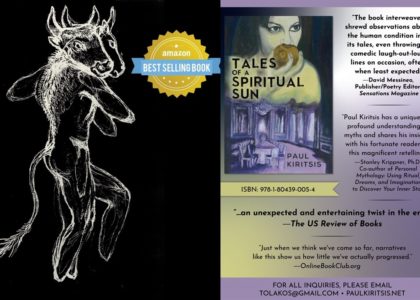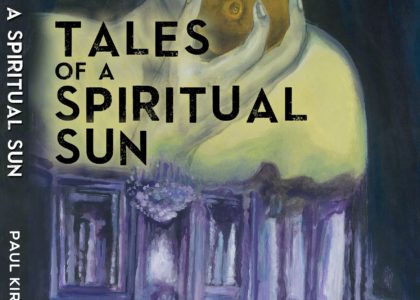
The belief in paranormal denizens called vampires (vrykolakas or katakhanas in Greek) who subsist in the sphere of the living by feeding on a pranic, sustaining life force, usually in the form of blood, may in fact predate the advent of civilization itself. Contrary to popular twenty-first century thought, folkloristic conceptions of vampires weren’t introduced into the region of Greece proper by the Slavic invasion of 587 ce, but were instead the product of oral folklore that had evolved independently and exclusively on the Aegean islands from the time the ancient Greeks conceived the eschatological lore of Hades. In actual fact, a great many of the permanent inhabitants of classical Hades, or more properly of Erebus, have been ascribed by scholars as ancient precursors to the modern phenomenon which reentered human collective consciousness in the early years of the eighteenth century.
Foremost of these ravenous predators was the Empusae, a nonphysical being thought to be the daughter of the witch Hecate. She often appeared as a woman of sublime beauty and induced such prurience in young men that none could resist her. Afterwards, as they slept complacent in their beds, she bit their jugular vein and drained them of blood. Another rancid ghoul of the nether regions who exhibited analogous habits was Lamia, though it appears she preferred the taste of children. Perhaps the vilest, most despicable of all primeval bloodsuckers were the lurid Stringles. These theriomorphic creatures resembled Egyptian ba spirits (personifications of the Western notion of the nonphysical soul) in that they took the guise of human-headed birds. But unlike their Egyptian antecedents, the Stringles, preying on anything with visible veins and arteries, were anything but benign.
In the annals of classical literature there are numerous examples of embryonic vampirism, or the necessitation of blood to regain vitality. When the Ithacan soldier-king Odysseus descended into the realm of Hades to consult, in the personage of Tiresias, the wisest mortal to have ever lived, he was required to sacrifice a young ram and a black ewe near a subterranean cave of the nether regions. The ensuing river of blood infused the dead with temporary strength in the form of pranic life force, thus enabling the wise man to speak and deliver his dour premonition of the future. On the same daunting quest, Odysseus’s dead mother was able to communicate with him only after she’d gulped down a few mouthfuls of the life-giving substance.
Also, the repercussion for ancient orators who did not abide by a sworn oath was either rejection by the multi-headed guardian dog Cerberus at the gates of Hades, expulsion by the very earth one was interred into, or resistance to bodily putrefaction after death. All variants seem to suggest that the penalty for non-adherence to the moral and ethical codes of the time was transfiguration into an undead prank of sorts. In Euripides’ Hippolytus, the conviction is immortalized in Hippolytus’ heartfelt words to his Minotaur-slaying father, Theseus, ‘In death may neither sea nor earth receive my flesh, if I have proven false.’
Further still, Plato’s doctrine of metempsychosis or reincarnation and the multiple incarnations of the soul on earth drummed a very real fear into the people of antiquity. Retribution for crimes committed against one’s person during the course of a lifetime could be sought in subsequent incarnations or even extorted after death. Consequently, a victim’s return to the material realm for the sake of justice was not only feared but anticipated by the perpetrator of the transgression. This may elucidate why bodies disinterred from pagan burial grounds have been found horribly mutilated. Often the arms have been severed at the wrists and legs at the ankles, with the corresponding body parts either tucked under the cadaver’s armpits and between their thighs or bound tightly to the chest with a noose. The actions were both a literal and symbolic gesture to thwart the victim’s return from the dead.
According to the Hellenistic tradition of Byzantine times, it was possible for a human soul to become trapped in a decaying carcass, wafting aimlessly between the realm of the living and the departed. The islanders of the Aegean called these undead revenants Alastores or Wanderers. It appears that the likelihood of suffering such a tragic fate increased if one had corroborated with evil beings during the course of one’s lifetime, if they were suicide victims, witches or sorcerers, if they were in turn bitten by a vampire, or if they were unlucky enough to become possessed by disembodied spirits at the time of their passing. The Byzantine Greeks unconsciously appropriated many ancient practices to conform to the eschatological beliefs regarding the dead that were promulgated by the church fathers during the Middle Ages, namely the undisputed existence of a Christian Hell and Purgatory.
Just as their predecessors had at one time placed an obolus in the mouth of the deceased to discourage demons and other spirits from taking possession of and utilizing the body to enact their evil machinations, the Greeks of the Byzantine Empire buried their dead with a wax cross and a piece of pottery inscribed with the words ‘Jesus Christ conquers’ to deter reinvigoration at the hands of Satanael and his minions. Many alternative methods were conceived and utilized to prevent transfiguration in the centuries that followed. Some of these included scalding the body with boiling oil, piecing the heart with an iron spit or black-handled knife, stuffing the mouth with onions or rocks marked with black crosses, and pouring either sulphur or seawater over the grave in question before draping a fishnet over it. The most potent defense against vampirism was dissolution through cremation, although this method was implemented only as a last resort, seeing that the incineration of a body anointed with holy oil was, and still is, forbidden by the Greek Orthodox Church.
During the Ottoman occupation, the parochial selection marking those liable to become vampires expanded to include criminals, the terminally ill, pathological liars, swindlers, the cursed and those excommunicated by the church fathers for such scandals as marrying a relative. Other more outrageous notions were also added to the list of damnation; individuals who hadn’t receive mandatory funerary or baptismal rites, offspring conceived on the days of important religious festivities, hunters who’d sampled the flesh of any animal that had been overwhelmed by a wolf, and loners were also heavily predisposed to becoming vampires. Unlike their northern cousins, the vampiric entities that terrorized the Miloan inhabitants never coalesced under a unifying physical characteristic: some looked typically human; some were merely incorporeal and as a consequence powerless in imposing change in the physical world of cause and effect; some presented themselves as uncouth and nominally violent, having long ago surpassed the necessity of social etiquette; some had purpled or red faces with prominent incisors like carnivorous lions or wolves; some, with glistening black skin, glowed in the dark; while yet others lurked about on all fours with more exotic features such as goat skins, elephant trunks and cyclopean eyes. Just like the primordial Nereids, nearly all of them encompassed the ability to change shape at will.
In Greece proper, the mountainous terrain sometimes formed impenetrable geographical barriers so that village settlements were cut off from one another, often for extended periods of time. The implications were that regional folkloristic tradition concerning vampires and other supernatural beings didn’t proliferate far and seldom intermingled with anything analogous in a neighboring area. These independent branches eventually forged a rich, multifaceted substratum of collective beliefs around the core concept of what actually defined vampirism; yet simultaneously introduced the subtle problem of regional discrepancies. Thus the actual time that these undead revenants rose from their graves came to be widely disputed. On the island of Thasos, vampires only rose in the preternatural world of dreams brought to fruition by sleep itself. Greeks living on the intermittent plains of the Greek state of Macedonia believed they arose on the night of the full moon. Alternatively, the islanders of Samos and Mytilene in the North Aegean Sea alleged that vampires walked after midnight, but were restricted to the immediate vicinity of their graves. On Amorgos, the easternmost of the Aegean Cycladic island group, vampires enjoyed an existence unfettered by the very circumstances detrimental to their survival by the northerners, i.e. time and spacial limits. They could walk about by day, unencumbered by the very sunlight that was supposed to render them handfuls of dust.
Nevertheless, all variant traditions agreed on the quintessential characteristic which defined all forms of vampirism as malevolence. Vampires were filthy, ravenous predators who nurtured and spread contagion, murdered for the sadistic pleasure that the heinous act promulgated within them, incited pandemonium and slathered about amidst the aftermath of any community depredation. They loitered about in inconspicuous areas, vandalizing village churches, defecated on consecrated ground and busied themselves with mischief until the first light of dawn. Like the unruly bloodsuckers confined to the nether regions of classical Hades, vampires periodically fed on freshly cut jugular blood to sustain their existence. Once in a while they might also stumble across raw liver, the vampiric equivalent of rib-eye steak.
The belief in these creatures of the dark became so pervasive that it evolved into mass hysteria and culminated in numerous public executions. Despite the doomsday scenario that the vampiric egregore cultivated during the later Middle Ages, the Hellenes of Greece proper and the islands were not without defense. At this time, the ritual and ceremonial magic which had formed an essential component of the fertility religions of the pre-Christian world (known as Wicca) had withered from Western collective consciousness. Foremost in confounding its true meaning and purpose were the church fathers who implemented their strict doctrines of conventional Christian theology. They aptly demoted the pagan practice as a denomination presided over by the Devil and his minions, and consequently declared it a Christian heresy that both attracted to its practitioner the fate of eternal damnation and greatly augmented the chance of becoming a vampire.
Fearing the implications of practical magic, the superstitious masses sought to ward off evil by brandishing mundane items or possessions of deep personal significance. Peasants resorted to nailing crosses made of reeds behind their doors, sealing their keyholes with bread anointed with holy water from the local church and spraying mustard seed onto their roofs. Some went so far as to spear pieces of a pig’s tongue to their porch door with a nail from a coffin. Miloan sailors and captains from the old Capitol of Kastro appear to have devised more flamboyant and inventive forms to deter vampires from harassing them. They drew insulting open-handed gestures onto their wooden doors, or alternatively dug a five pointed star onto it before driving a black-handled knife through the star’s center. According to Miloan tradition, individuals born on a Saturday exhibited preeminence over all vampiric entities because their ‘soul spark’ was dual. Their spirit double could morph into a prodigious dog that would intimidate and chase them away.
Before the coming of Christianity to the area of Greece proper and the Slavonic immigration to the Balkan region of Europe, classical Hellenistic spirituality and eschatological belief laid the foundations for later vampiric folklore by hinting that an unclean spirit or demon could possess a decomposing body. The Greeks called these undead ‘revenants’ or Alastores, after the Hadean demon Alastor who led humans to decadence and sin and then punished them for it. They were originally preternatural beings who functioned within the square of reason and logic, returning from the dimension of the afterlife to enact vengeance upon those who’d grievously sinned against them during the course of their lifetime. Herein, a mythological tenet outlines the psychic mechanism of higher consciousness which delineates the ways of ethical and moral justice and its eternal inherence within the whole of humankind. When these supranormal earth spirits became confounded with Christian demons, any benign or righteous qualities that rustics had previously ascribed to them fell away; the undead revenants then became obstreperous and vengeful tools used by Satanael to further obstruct the Christian path to redemption. The arrival of Slavic lore concerning werewolves or were bears and vampires enhanced the pre-existing Hellenic tradition which extended from the northernmost regions of Macedonia to the southern Cycladic islands of Milos and Santorini, as well as distant Crete. In fact, the conviction in undead revenants was most potent in the southern Aegean, a region never subjected to Slavonic influence. Thus, it is highly probable that the Greeks only borrowed the name vampir from the Slavonic adaptation of a very pagan invention.
These two very separate and distinct traditions, the Slavonic and the Greek, found a spirited ally in one another and had completely merged by the seventeenth century under the name of vrykolakas. After the hybrid entity stitched itself together by borrowing traits from both traditions, it discarded all its milder ones and paraded in the entrails of predation and hostility. Vampires were sentient beings but without a slither of human conscience; they were wholly sinful and irrationally bloodthirsty. The Greek Orthodox Church saw this outrageous superstition as a perfect opportunity to tighten the reigns on their religious monopoly. They become increasingly secular in a bid to consolidate terrestrial authority over the Greek-speaking Christian population. In the eyes of the church fathers, disobedience to the law of ecclesiastical doctrine was an evil heresy and was punishable by excommunication; therefore, those who transgressed from the divinely appointed role that the church credited to itself had been corrupted by the Devil, and were likely to become vampires. Interestingly, the desperation to maintain popular belief in the horrifying consequence of excommunication was so great that the church unconsciously mounted an insurrection against its own teaching. By aiding and abetting mass hysteria and then repudiating accountability for it, the institution itself became an incarnation of the same intrinsic malevolence it was fighting to subdue. Nonetheless, it appears the belief subsisted until the late eighteenth century.
On the island of Milos, it was predetermined that vampires went about their mischief during the week and rested on Saturdays. Similarly, the Biblical creation account of the first chapter of Genesis (2: 1-3) explicates that Yehovah-Elohim created the world in six days and rested on the seventh, the Sabbath or Saturday. This not only juxtaposes but identifies the Hebrew Yahweh with the amalgam of repugnant and deformed undead that became the very vessels through which the Devil corrupted and tyrannized over human beings. Harking back to the last chapter, it was established that the earliest ‘heretical’ Christians, the Gnostics, had sprouted on Milos as early as the first and second centuries ce. These sects fostered such contemptuous aversion towards Yahweh and his meaningless laws that they cast him in the role of an ignorant and conceited demon called Yaldabaoth. In knowledge of this, there is much credence to the notion that beliefs pertaining to the sphere of vampiric entities didn’t arise randomly at all. Instead, they were an unconscious appropriation of Gnostic mythology so psychically resonant that relics were preserved in folk memory long after the self-declared orthodoxy of secular Christianity tried to decimate it.
In 1897, vampires entered the sphere of popular literature with Bram Stoker’s Dracula, a novel in which the protagonist is none other than a vampiric entity from Transylvania named Count Dracula. Vampires would go on to enter the literary genres of horror fiction, invasion literature and the gothic novel. One of my favorites in this style was The Travelling Vampire Show (2000) by the late Richard Laymon. (I was a big Richard Laymon fan when I was a teenager.) When it comes to the evolution of vampire literature, what most don’t actually realize is that Dracula was actually influenced by a novella written by John Polidori, a doctor and close friend of Lord Byron. The novella, titled The Vampyre, was published sometime between 1817-1819 and set the tone for both James Malcolm Rainer’s Varney the Vampire (1847) and Dracula, both works that came a great many decades afterward. Thus it appears that the Greeks played a role in the transmission of oral folklore about vampires to the West through the early literature of the nineteenth century.
I will conclude today’s post on Greek vampires with a quote from American writer Jack Handy, famous for his Deep Thoughts comedy sketches.
“One thing vampire children are taught is, never run with a wooden stake.”









